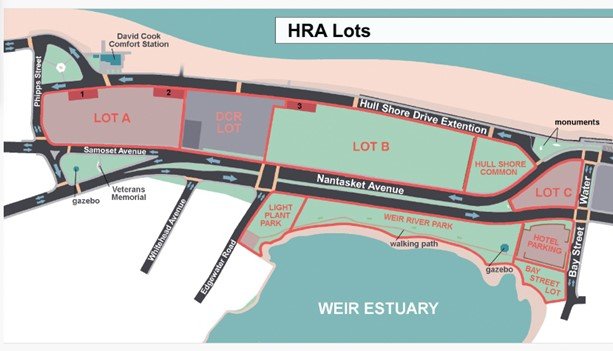Board hears town manager’s $52.6M budget plan; sets HRA parking capacity at 900 cars
/By Carol Britton Meyer
The select board addressed a full agenda this week – from an update on the new 125-foot Strawberry Hill water tank and appointing members to the town’s USA Semiquincentennial (250th) Anniversary Committee to the proposed fiscal 2026 municipal budget and a follow-up discussion with the Hull Redevelopment Authority.
Town Manager Jennifer Constable presented a proposed $52.6 million fiscal 2026 municipal budget, representing a 4.84%, or $2.4 million, increase over the fiscal 2025 figure.
Major expenditures include health insurance, pension liability, and collective bargaining agreements, debt, seawall repairs, and restoration of Fort Revere, among others.
Included in the operating budget are the addition of two full-time fire department paramedic/EMT positions; a patrol and desk clerk position for the police department; and union and non-union salary adjustments.
Capital recommendations include IT system upgrades, town website upgrades and redesign, public safety replacement vehicles, a columbarium for the cemetery, repairs to the Draper Avenue pump station, DPW barn and salt shed, and fences, funds for the 250th celebration, and townwide line painting and seawall program.
Constable noted that there is no proposed operational override of Proposition 2-1/2, which is not the case in a number of surrounding towns.
The May 5 annual town meeting has the final say on all warrant articles, including the proposed school, municipal, and capital budgets.
Click here for the town manager’s budget presentation to the board.
Strawberry Hill water tank update
On a separate agenda item, Weir River Water System Managing Director/Superintendent Russell Tierney told the board that the new one-million-gallon Strawberry Hill water tank is expected to be online by fall 2027. A new pump station will be located in Hingham.
The tank, which will improve water quality and stabilize the pressure in the system, will display the name of the water company and also “Welcome to Hull.”
Tierney said he intends to talk to the neighbors living in the area to update them on the project. The new tank will be about double the capacity of the former 100-foot Strawberry Hill tank, which was taken down after a 2008 study by the water company determined the 75-year-old structure was no longer needed.
“We’ll do a balloon test [to show how high the water tank will be],” Tierney said.
While no rate increases are planned for fiscal 2026, an annual capital investment charge of about $65 a year per single-family dwelling will be added to customers’ bills starting July 1 to pay for the final design and construction of the water tank.
In other WRWS news, Tierney reported that $16 million in infrastructure repairs were made without the need to raise the rates.
In other business…
• Constable presented the annual $11.5 million annual light plant budget, which goes by the calendar year instead of the fiscal year.
A rate increase is under consideration. “There hasn’t been one for some time,” she said.
The issue of the generators that have been rented for the past several years in the case of a National Grid power outage was raised during the meeting.
To date, $3.5 million has been spent, while the generators have kicked in only for a few hours during that time period.
“The light board has been debating this issue,” light board member Tom Burns said. “Some members want to keep them, while others want to get rid of them.”
Select board member Jerry Taverna noted that some residents have purchased their own generators but don’t receive a credit on their bills.
Select board member Brian McCarthy noted that there have been “unprecedented high winds in the last few months, and there have been no power outages.”
Chair Irwin Nesoff suggested inserting a questionnaire in a light bill to gauge ratepayers’ interest in continuing with the generators in subsequent years.
• At his request, former select board member John Reilly was appointed as chair of the town’s 250th anniversary committee. He also chaired a similar committee to celebrate Hull’s 375th anniversary.
Board member Greg Grey, who also served on the 375th committee, was appointed to the 250th committee as the select board’s liaison.
Overall, the committee is charged with planning townwide activities commemorating the 250th anniversary of the Declaration of Independence; focusing on remembrances concentrated throughout 2025-26; coordinating events related to the founding of the country; and aligning Hull events with other local, state, regional, and federal commemorations.
“We’re thinking about a yearlong celebration, including fireworks, music, art, the town’s and country’s history, a field day, gala, and maybe dances, and the committee will update the board monthly,” Reilly said. “It will be an inclusive event, with a theme that could be ‘The promise of America.’ We’re ready to go.”
There will be numerous community events offering volunteer engagement for interested residents with a passion for local history.
Peter Preble, pastor of St. Nicholas United Methodist Church, Hull Lifesaving Museum Director of Development Maureen Gillis, and former town counsel James Lampke already have been appointed to the committee.
• In a follow-up to a select board discussion with the Hull Redevelopment Authority a couple of weeks ago, the main subject this week was whether the board would support the HRA’s inclusion of 900 parking spaces in the request for proposals for a parking lot operator this summer. The paid parking season begins May 1. Board member Dan Kernan was unable to attend.
Following a brief discussion, the board voted 4-1 in favor of allowing 900 cars to be parked in lots A, B, and C.
Grey was the nay vote. “This was never the intent for the property,” he said.
Zaia noted that there have been three responses to the parking operator RFP already.
The affirmative vote was contingent on the HRA working with the town’s piping plover ambassadors again this year to educate beachgoers about the plovers’ presence.
Select board member Brian McCarthy said he might not be inclined to vote in the affirmative again next year if there’s no plan for use of the HRA property by then – noting, half jokingly – that he would like to that happen in his lifetime.
Like what you’re reading? Stay informed and support our work with a Hull Times subscription by clicking here.
Do you have an opinion to share? Click here to write a Letter to the Editor.
© 2025 The Hull Times. All rights reserved.


































